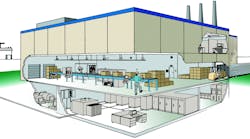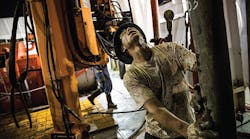Editor's note: In this month's article, Mike Holt discusses the 2011 NE Code changes that affect wiring in ducts and other plenums and conductor ampacity.
300.22 Wiring in Ducts and Other Spaces for Environmental Air (Plenums)
13
Extensive revisions have been made to the language of this section, and a new subsection was added addressing cable trays.
300.22 Wiring in Ducts Not for Air Handling, Fabricated Ducts for Environmental Air, and Other Spaces For Environmental Air (Plenums). The provisions of this section apply to the installation and uses of electrical wiring and equipment in ducts used for dust, loose stock, or vapor removal; ducts specifically fabricated for environmental air, and spaces used for environmental air (plenums).
-
Ducts Used for Dust, Loose Stock, or Vapor. Ducts that transport dust, loose stock, or vapors must not have any wiring method installed within them.
-
Ducts Specifically Fabricated for Environmental Air. If necessary for direct action upon, or sensing of, the contained air, Type MC cable that has a smooth or corrugated impervious metal sheath without an overall nonmetallic covering, electrical metallic tubing, flexible metallic tubing, intermediate metal conduit, or rigid metal conduit without an overall nonmetallic covering can be installed in ducts specifically fabricated to transport environmental air. Flexible metal conduit in lengths not exceeding 4 ft can be used to connect physically adjustable equipment and devices within the fabricated duct.
Equipment is only permitted within the duct specifically fabricated to transport environmental air if necessary for the direct action upon, or sensing of, the contained air. Equipment, devices, and/or illumination are only permitted to be installed in the duct if necessary to facilitate maintenance and repair.
-
Other Spaces Used for Environmental Air (Plenums). This section applies to wiring and equipment in spaces not specifically fabricated for environmental air-handling purposes (plenums) but used for air-handling purposes as a plenum. This requirement doesn't apply to habitable rooms or areas of buildings, the prime purpose of which isn't air handling.
Note 1: The spaces above a suspended ceiling or below a raised floor used for environmental air are examples of the type of space to which this section applies. (Fig. 12)
Note 2: The phrase “other space used for environmental air (plenum)” correlates with the term “plenum” in NFPA 90A, Standard for the Installation of Air-Conditioning and Ventilating Systems, and other mechanical codes where the plenum is used for return air purposes, as well as some other air-handling spaces.
-
Wiring Methods. Electrical metallic tubing, rigid metal conduit, intermediate metal conduit, armored cable, metal-clad cable without a nonmetallic cover, and flexible metal conduit can be installed in environmental air spaces. If accessible, surface metal raceways or metal wireways with metal covers can be installed in environmental air spaces.
-
Cable Tray Systems.
- Metal Cable Tray Systems. Metal cable tray systems can be installed to support the wiring methods and equipment permitted by this section. (Fig. 13)
-
Equipment. Electrical equipment with a metal enclosure or nonmetallic enclosures listed for use within an air-handling space (plenum) and having adequate fire-resistant and low-smoke-producing characteristics can be installed.
Analysis: There's long been confusion about the terms “plenum” and “other space(s) used for environmental air.” While nearly all mechanical codes (NFPA 90A, Standard for the Installation of Air-Conditioning and Ventilating Systems, International Mechanical Code (IMC), and Uniform Mechanical Code (UMC)) use the term “plenum” for anything that moves environmental air, the NEC only referred to a physically constructed duct as a “plenum.” The space beneath a raised floor and the space above a suspended ceiling (when used for air handling) were referred to as “other spaces used for environmental air.” Obviously, the Code shouldn't be the document that defines air system components, yet manufacturers were forced to have their product literature include provision for these “other spaces,” which created massive confusion for people installing, designing and inspecting mechanical systems. The confusion was rampant enough to require an Informational Note in the NEC trying to explain what these spaces really were. With the change, a component of an air-handling system that's created for the sole purpose of moving air (such as a duct made of tin or drywall) is now called a “duct specifically fabricated for environmental air.” The space above a ceiling or below a floor that's used for air moving isn't fabricated for that sole purpose; therefore, it isn't a “duct,” according to mechanical codes. These spaces are now referred to as “other spaces used for environmental air (plenums),” which correlates with other codes and also has the desired effect of using commonly accepted trade language — most people refer to the space above a suspended ceiling as a “plenum ceiling,” not an “other space used for environmental air ceiling.”
Additional changes to this section include a new provision dealing with cable trays in other spaces used for environmental air (plenums), which requires these cable trays to be metallic.
Solid metal cable trays with metal covers can be used to support and enclose wiring methods that traditionally weren't allowed in these locations.
310.15 Conductor Ampacity
14
This section, dealing with the ampacity of conductors, has been extensively revised.
310.15(B) Ampacity Table. The allowable conductor ampacities listed in Table 310.15(B)(16) are based on conditions where the ambient temperature isn't more than 86°F, and no more than three current-carrying conductors are bundled together.
The temperature correction and adjustment factors apply to the ampacity for the temperature rating of the conductor, provided the corrected and adjusted ampacity doesn't exceed the ampacity for the temperature rating of the termination in accordance with the provisions of 110.14(C).
(2) Ambient Temperature Correction Factors. When conductors are installed in an ambient temperature other than 78°F to 86°F, the ampacities listed in Table 310.15(B)(16) must be corrected in accordance with the multipliers listed in Table 310.15(B)(2)(a). (Fig. 14)
(4) Ampacity adjustment factors don't apply to conductors within Type AC or Type MC cable under the following conditions:
-
The cables don't have an outer jacket,
-
Each cable has no more than three current-carrying conductors,
-
The conductors are 12 AWG copper, and
-
No more than 20 current-carrying conductors (ten 2-wire cables or six 3-wire cables) are installed without maintaining spacing for a continuous length longer than 24 in.
(5) Ampacity adjustment of 60% applies to conductors within Type AC or Type MC cable without an overall outer jacket under the following conditions:
(b) The number of current-carrying conductors exceeds 20.
(c) The cables are stacked or bundled longer that measure 24 in. without spacing being maintained.
Analysis: In this edition of the Code, the term “derate(ing)” isn't used at all, except in a few instances. The term “ampacity adjustment” is used throughout the NEC when referring to conductors that are bundled or used on rooftops, and the term “correction” is used when conductors are subjected to temperatures other than 86°F.
Conductors with insulation temperature ratings higher than the termination's temperature rating can be used for conductor ampacity adjustment, correction, or both [110.14(C)]. This means conductor ampacity must be based on the conductor's insulation temperature rating listed in Table 310.15(B)(16), as adjusted for ambient temperature correction factors, conductor bundling adjustment factors, or both. This change clarifies that, after applying these adjustments and corrections, the resulting ampacity still can't exceed the temperature limitations of the equipment termination.
The temperature correction factors formerly found at the bottom of (then) Table 310.16 in the 2008 NEC, were some of the least user-friendly in the Code. This new table provides a remarkably easier format, with less confusion and proper application being the end result. An interesting addition to this table is borrowed from the Canadian Electrical Code — the allowance of smaller conductors when installed in an ambient temperature of less than 70°F. With this allowance, the NEC user can use up to 115% of the conductor's ampacity in certain conditions, which can result in a smaller conductor. While previous editions of the Code recognized colder environments, it allowed only for an increase to 104% of the conductor's ampacity — a value that never really made the math worthwhile.
Previous editions of the NEC used the term “nipple” to describe a raceway that's 24 in. or less in length. This resulted in Code users debating about the physical characteristics of the raceways, such as whether or not the raceway could contain bends. This change takes away that argument by removing the term “nipple(s)” and replacing it with “raceway(s).” One no longer needs to guess at the intent of this section and now needs only to measure the length and determine the appropriate rules.
The term “bundled” has been used for several Code cycles to describe when ampacity adjustment is required. Because the term isn't defined in Art. 100, many people struggle in their attempts to determine when to apply the adjustment provisions of this section. While the phrase “installed without maintaining spacing” is also not defined, some NEC users may find it an easier phrase to understand and apply. This change isn't intended to be a technical one, but rather an editorial one.
New to the 2008 Code came a rule requiring that all conductors installed in conduits on rooftops have their ampacities adjusted dramatically. The term “conduit,” while not defined in the NEC, doesn't include raceways such as EMT, ENT and FMT. With this change, conductors installed in these raceways will now have to have their ampacities adjusted as well.
The ampacity of some conductors in Table 310.15(B)(16) (formerly 310.16) didn't match those found in the Canadian Electrical Code and were therefore changed. While no technical evidence was submitted showing insulation failure of the conductors, this proposal was passed. The end result was a change to the ampacities of:
Copper conductors: 14, 12, 3, and 1 AWG, and 600kcmil, 1,500kcmil and 2,000kcmil.
Aluminum conductors: 12, 8, and 6 AWG, and 300kcmil, 700kcmil, and 800kcmil.








